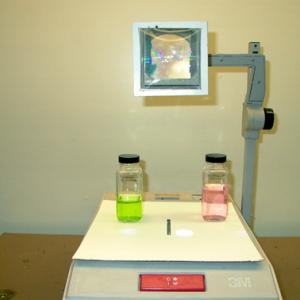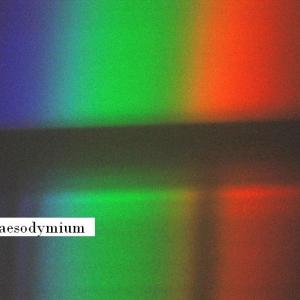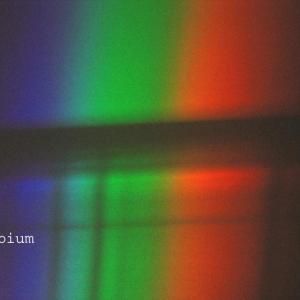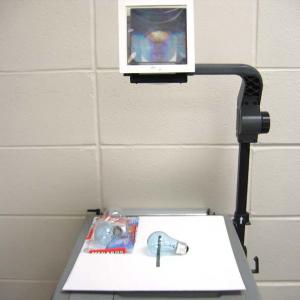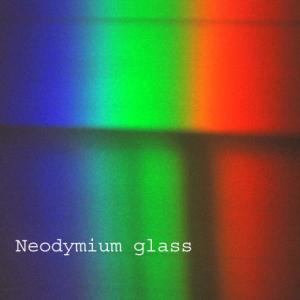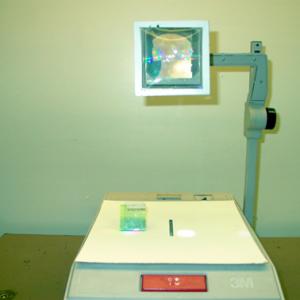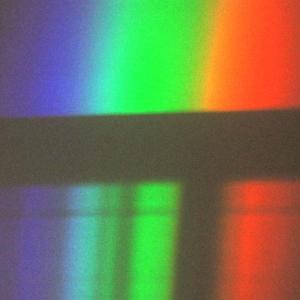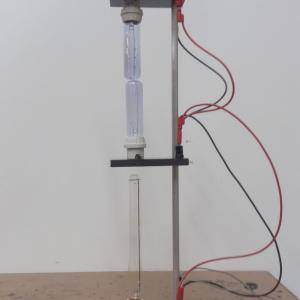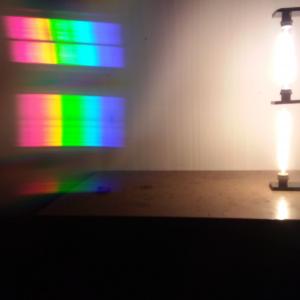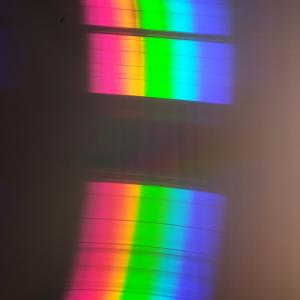College of Liberal Arts & Sciences
7B11.65 - Spectral Lines/Spectroscopy - Rare Earths, Didymium Glass
See also 7B11.65 in Astronomy. NOTE: Make sure the liquid rare earth solutions are stored in an upright position to prevent leakage. Some evaporation may occur over time. In that case just add distilled water to the remaining solutions to replentish.
Position the slit slide on the overhead and place the holographic grating in the exit beam. Place the desired rare earth over half of the slit. In this fashion you will be able to see the regular spectrum and an absorption spectrum.
NOTE: The spectrum will be a molecular absorption (band absorption).
Holmium should have absorption lines at 415, 450, 535, and 640 nm, with half-widths of less than 5 nm.
The GE "Reveal" bulbs have a slight blue tint to them due to the neodymium added to the glass envelope. Just place the glass of the bulb into the light path to see the spectrum.
Place the mask on the overhead and position the grating in the exit beam. Place the didymium glass so that it covers one half of the slit. In this fashion you will be able to see the regular spectrum and an absorption spectrum.
NOTE: The spectrum will be a molecular absorption (band absorption).
Didymium is a mixture of neodymium and praseodymium.
There should be 5 absorption lines at 430, 450, 530, 580, and 690 nm, with half-widths of about 10 nm.
The long spectrum tube apparatus shows a rainbow spectrum at the bottom with the two Reveal tube bulbs on the top which have some Neodymium in the glass envelope. This will show that some portions of the yellow, orange, and green parts of the spectrum are missing from the top spectra.
- Jennifer J. Birriel, "More Absorption Band Demos", TPT, Vol. 48, # 5, May 2010, p. 278.
- Adam J. Beehler, "Demonstrating Spectral Band Absorption with A Neodymium Light Bulb", TPT, Vol. 48, # 3, March 2010, p. 206.
- "Figuring Physics", TPT, Vol. 43, # 2, Feb. 2005, p. 117.
- Kenneth Brecher, "Do Atoms Really "Emit" Absorption Lines?", TPT, Vol. 29, # 7, July 1991, p. 454.
- Simon George and Hassan Sharifian, "Absorption Spectra of Rare Earths - A Demonstration and an Experiment", AJP, Vol. 65, #4, Apr. 1997, p. 352.
- George M. Hopkins, "New Chromotrope", Experimental Science, p. 218.
- "15, Absorption Spectrum", Experiments in Optics, Part 1, J. Klinger Scientific Apparatus Corp., Bulletin 101.
- L-109: "Band Absorption Spectrum", Demonstration Experiments in Physics, McGraw-Hill Book Company, New York, 1938; p. 415.
- Borislaw Bilash II, “Absorption Spectra“, A Demo A Day – A Year of Physical Science Demonstrations, p. 115.
Disclaimer: These demonstrations are provided only for illustrative use by persons affiliated with The University of Iowa and only under the direction of a trained instructor or physicist. The University of Iowa is not responsible for demonstrations performed by those using their own equipment or who choose to use this reference material for their own purpose. The demonstrations included here are within the public domain and can be found in materials contained in libraries, bookstores, and through electronic sources. Performing all or any portion of any of these demonstrations, with or without revisions not depicted here entails inherent risks. These risks include, without limitation, bodily injury (and possibly death), including risks to health that may be temporary or permanent and that may exacerbate a pre-existing medical condition; and property loss or damage. Anyone performing any part of these demonstrations, even with revisions, knowingly and voluntarily assumes all risks associated with them.
